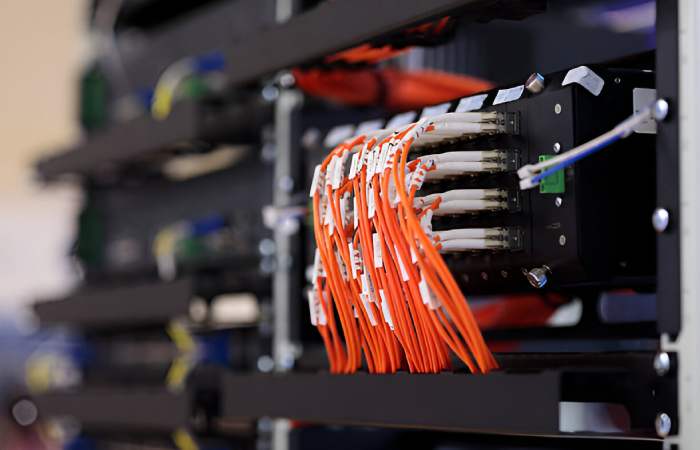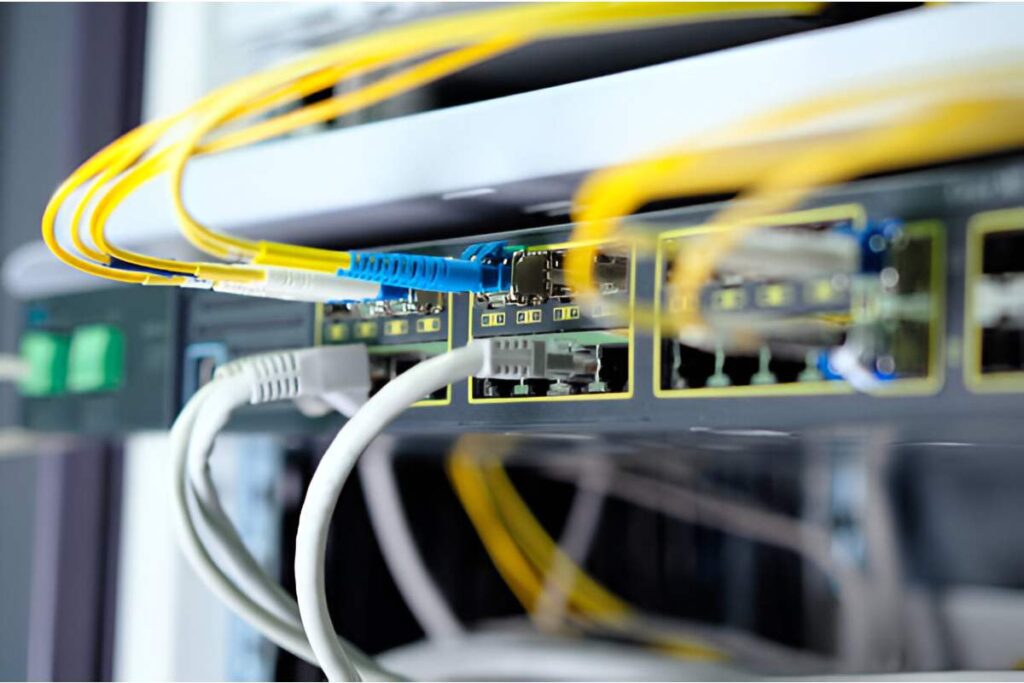In today’s congested world, high-speed internet is no longer a luxury but a necessity. Whether watching your favourite series, working from home, or playing online video games, your internet connection keeps everything running smoothly.
At the heart of today’s fibre optic internet systems is the optical network terminal (ONT), an often overlooked but essential device.
Today, we’ll discuss what an ONT is, how it works, its components, such as the fibre optic cable and the ONT, and why providers like Verizon use it to offer fibre optic services. We’ll also cover practical aspects such as ONT installation, troubleshooting, and more.
What is an Optical Network Terminal?
Let’s start with the basics: what is an optical network terminal?
An optical network terminal, often referred to as an ONT or optical network module, is a device that acts as a bridge between your home or office and the fibre optic network provided by your Internet Service Provider (ISP).
An ONT converter converts light signals travelling through the fibre optic cable into electrical signals that your devices, such as computers, TVs, or routers, can understand.
Unlike traditional cable or DSL modems, an ONT modem is specifically designed for fibre optic networks. Which use light to transmit data at incredibly high speeds. This makes the fibre ONT a cornerstone of today’s internet infrastructure, providing the ultra-fast download and upload speeds necessary for today’s digital needs.
How Does an Optical Network Terminal Work?
Let’s take a step-by-step look at how an ONT works.
The ONT is typically installed at the customer’s premises, either inside the home or in an optical network distribution box mounted on an exterior wall.
Below is a simplified view of the entire process:
Signal reception:
A fibre optic cable transmits data through light pulses and connects to the ONT. This cable can be single-mode (for long-distance transmissions) or multimode (for short-distance transmissions).
Signal conversion:
Inside the fibre optic terminal, the ONT converts the sunny signals into electrical signals. Without this conversion, your devices cannot interpret the data arriving over the fibre optic cable.
Distribution:
The electrical signals are sent to your router or devices using Ethernet or Wi-Fi cables once converted. In some configurations, the ONT modem may have built-in routing capabilities, eliminating the need for a separate router.
Bi-directional communication:
The ONT also works in reverse, converting electrical signals from your devices into light signals to send data (such as downloads or requests) to the Internet Service Provider (ISP) network.
This seamless process ensures reliable, high-speed internet with minimal latency, making the fibre optic network unit a key player in fibre optic connectivity.
The Role of Optical Cables

Optical cable, or fibre optic cable, is a vital system component. These cables are thin glass or plastic filaments that transmit data through light pulses.
Unlike traditional copper cables, fibre optic cables are immune to electromagnetic interference, making them ideal for providing stable, high-speed internet over long distances.
There are two main kinds of optical cables:
Single-mode fibre optic cable:
Designed for long-distance data transmission, it is typically used by internet service providers to connect residential areas to their network nodes.
Multimode fibre optic cable:
Used for short distances, such as inside buildings, it supports multiple light paths, making it suitable for high-bandwidth applications.
Proper fibre optic cable installation is critical to ensure optimal performance. Technicians must handle these cables carefully to prevent the delicate fibres from being bent or damaged. Which can cause distorted light signals.
Optical Network Terminal Box: The Unsung Hero
An optical network distribution box, also known as an ONT box, ONT cabinet, or fibre optic distribution box, is a protective enclosure for an ONT device.
An ONT distribution box is typically installed on an exterior wall or inside a utility closet and protects the equipment from environmental elements such as rain, dust, and extreme temperatures.
A fibre optic distribution box also contains a fibre optic splitter, which divides the incoming fibre signal to support multiple connections in the home. This ensures that all devices in your home can connect to the high-speed internet provided by the fibre optic network module.
The ONT box is a familiar sight for homeowners or renters when installing an ONT. Professionals will secure the box, connect the fibre optic cable, and configure the ONT to ensure uninterrupted internet service.
Verizon Optical Network Terminal
Regarding fibre internet, Verizon is best known for its Fios service. A Verizon Optical Network Terminal, or Verizon Fios ONT, is a specialised ONT device designed to work with Verizon’s fibre network. If you’re a Fios subscriber, you’ve probably seen a Verizon ONT set-top box installed on your property or home.
A Verizon Fios modem (often integrated with a Verizon Fibre router) works with a Verizon ONT to provide gigabit internet, television, and phone service.
Setting up an ONT for Verizon subscribers typically requires a professional technician to install the fibre cable and ONT properly.
However, as with any technology, problems can arise. Troubleshooting a Verizon ONT may involve checking for loose connections, verifying the integrity of the fibre optic cable, or resetting the Verizon Fios ONT to resolve connection issues.
Why Fibre Optic Technology Matters!
The development of fibre optic internet, which operates on devices such as optical network terminals, has transformed how we connect. Compared to traditional copper systems, fibre optic networks offer:
- Speed: Fibre optic internet can offer speeds of up to 1 Gbps or more, significantly surpassing DSL or cable connections.
- Reliability: Fibre optic cables are less vulnerable to failures caused by weather conditions or interference.
- Scalability: Fibre optic systems can handle increased bandwidth as data needs grow without major infrastructure upgrades.
Practical Tips for ONT Installation and Maintenance
If you’re preparing to install an ONT, here are some tips to help ensure a smooth process:
Choose the correct location:
The fibre optic junction box should be installed in a dry and accessible location, ideally near your home’s fibre optic cable entrance.
Call a professional:
All installations require specialised tools and expertise, so trust your internet service provider (ISP).
Routine maintenance:
Periodically inspect the ONT casing for ciphers of wear or damage, particularly after storms or extreme weather conditions.
Troubleshooting:
If you’re experiencing connection issues, start with basic Verizon ONT troubleshooting steps, such as resetting the modem or checking the junction box for loose cables.
Frequently Asked Questions
1. What is the difference between an ONT and a modem?
An ONT device converts light signals from a fibre optic cable into electrical signals for your home network. In contrast, a traditional modem converts analogue signals (cable or DSL) into digital signals. In fibre optic systems, an ONT modem typically replaces or integrates with a conventional modem.
2. Can I install an optical network terminal myself?
The installation process often requires professional expertise due to the complexity of working with fibre optic cables and configuring ONTs. Therefore, contact your internet service provider (ISP) for assistance.
3. How do I troubleshoot my Verizon Fios ONT?
To troubleshoot your Verizon ONT, check your power and cable connections, restart your Verizon Fios ONT, and contact support if issues persist.
4. What type of optical cable is used for home internet?
Most home internet systems use single-mode fibre optics because of its ability to transmit data over long distances with minimal signal loss.
5. Why is my optical network terminal box making noise?
The fibre optic distribution box shouldn’t make any noise. If you hear it, it could indicate a faulty fan or an electrical issue. Communication your internet service provider (ISP) to have the ONT enclosure inspected.
The fibre optic network terminal keeps your fibre internet working by seamlessly connecting fiber optic cables to your devices through a fiber optic distribution box. Whether you use Verizon or a standard fiber optic ONT, this technology provides fast and reliable connectivity for your digital life.

